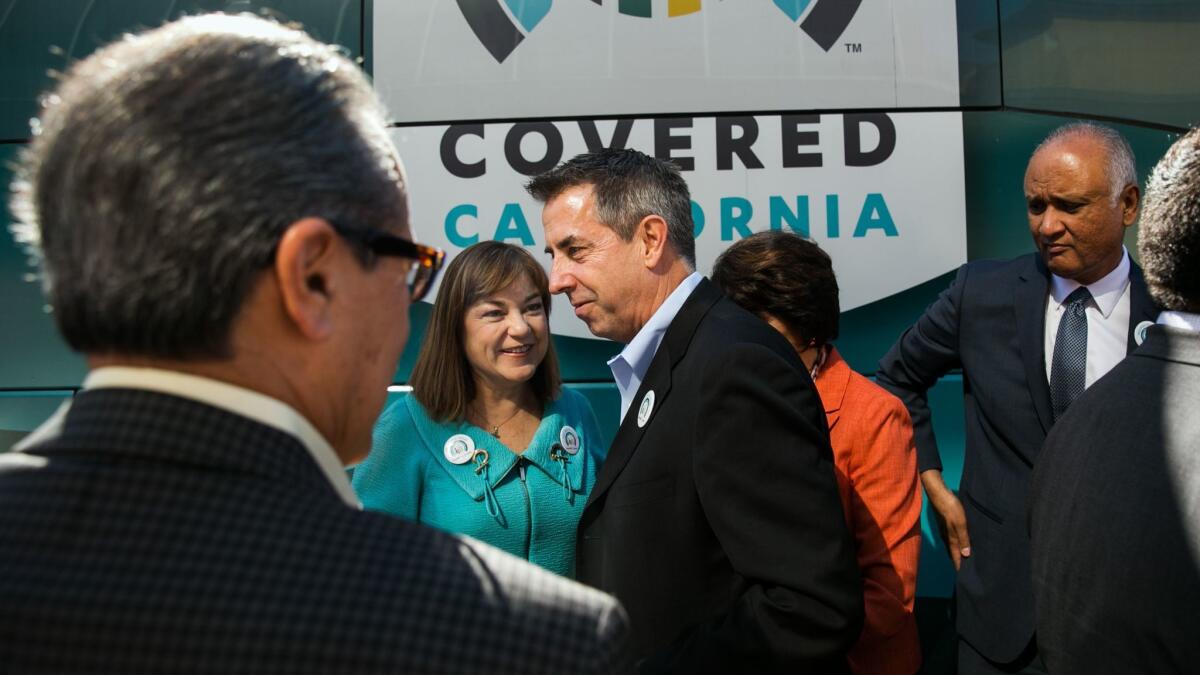Column: The first projections for Trumpcare 2019 are in: Expect rate increases of up to 30%

If anything is predictable about the vandalism of the Affordable Care Act perpetrated by President Trump and his healthcare henchmen, it’s that the costs of their handiwork will be felt by ordinary Americans for years to come.
Now, thanks to Covered California, the state’s ACA insurance exchange, we have the first estimate of what those costs will be for 2019. The bottom line is premium increases in the range of 16% to 30%.
Covered California’s report is titled “The Roller Coaster Continues.” That’s apt. Beyond a background increase in medical costs of 7% across the board, the other increases are highly responsive to federal policies. Since the Trump administration took office, those policies uniformly have pressured premiums higher. But obviously that doesn’t have to be the case.
The working middle class that are not getting subsidies got hit hardest in 2018 and would be hit hardest in 2019.
— Peter V. Lee, Covered California
Another important consideration is who will suffer most from the projected increases. It’s not the low- and moderate-income families who are insulated by federal premium subsidies, which rise as overall premiums climb. It’s families over the income limit for the subsidies, which is set at 400% of the federal poverty line. In 2018, that comes to $100,400 for a family of four.
It’s crucial to bear in mind that these are not wealthy households: Their median income is $75,000, the exchange’s report finds, compared to $66,000 for all individuals ages 19 to 64.
“The working middle class that are not getting subsidies got hit hardest in 2018 and would be hit hardest in 2019,” Peter V. Lee, Covered California’s executive director, told me.
The Trump administration began its assault on the Affordable Care Act virtually from the start. The White House canceled $5 million in paid advertising in the 39 states subject to the federal marketplace for the last week to 10 days of the 2017 open enrollment period, or as much as 80% for that period, which ended Jan. 31. That’s a crucial time for open enrollment, as it typically experiences a surge in sign-ups as people hustle to meet the deadline for coverage. Up to that point, enrollment was running ahead of 2016 figures; afterward, it dropped off sharply.
Trump repeated this strategy for 2018 open enrollment, slashing the advertising budget by a stunning 90%, to $10 million. The Department of Health and Human Services also cut funds by roughly 40% — to $36.8 million from $62.5 million — for nonprofit groups that employ “navigators,” those who help people in the individual market understand their options and sign up.
Its rationale was that anyone who was interested in signing up already had seen enough advertising, which is just stupid: Even Coca-Cola, which has the most recognizable brand in the world, still spends close to $15 billion a year on marketing.
By Covered California’s estimate, the marketing cutback is penny-wise and plain foolish. On the assumption that individuals who are eligible to sign up but fail to do so are on average 25% healthier, or less costly to the insurance pool, than the average enrollee, its actuaries estimate that premiums in the federal marketplace states will rise by about 1.3% in 2019 because of the cutback alone. That increase will cost about $1 billion nationwide, swamping the $90 million in so-called savings in marketing expenses.
The same effect will be seen from another initiative, the cancellation of the individual mandate penalty starting in 2019. The requirement that everyone carry health insurance or pay a penalty — it’s up to $695 a month for uncovered adults this year or 2.5% of household income, whichever is higher — has played an important role in persuading younger and healthier individuals to sign up.
But the penalty was cut to zero in the tax bill passed by the Republican-controlled Congress, a deliberate effort to undermine the ACA. Covered California reckons that, by making the insurance pool sicker and older on average, the change will drive premiums higher in 2019 by 8%, to 13%. That’s close to the estimate of the Congressional Budget Office, which estimated last year that eliminating the mandate would send premiums higher by 10%.
Covered California points out, properly, that many of these effects could be mitigated by federal actions. They include funding high-risk pools or reinsurance programs to moderate the impact of high-risk customers on insurance carrier finances. Spending $15 billion on those programs in 2019 and again in 2020 could produce a rate reduction averaging 12%, with a range of 9% to 16%. That would cut the overall cost to the federal government by about $10 billion by reducing the cost of premium subsidies.
Restoring marketing and outreach funds could reduce rates by 2% to 4% by relieving insurers of concerns about the risk profile of their customer base.
What’s most important — and surely most unattainable under the present White House and congressional leadership — is signaling the insurance markets and the public that the government is squarely behind the ACA, rather than determined to wreck it at whatever cost.
“Going into 2017,” the Covered California report observes, “the individual insurance markets were largely stabilizing in terms of enrollment and issuer profitability.” Yet rate increases in 2018 came in well above the core increases in medical costs. The difference was all because of Republican sabotage.
California escaped much of the damage because it has taken the ACA seriously. The state expanded Medicaid under the ACA, providing coverage to its neediest residents. Covered California has maintained a full three-month open enrollment period ending Jan. 31, even though the Trump Administration cut the period for signups in the federally-managed state exchanges in half, to six weeks ended Dec. 15. The state maintained a vigorous marketing and outreach effort to encourage holdouts to sign up.
As a result, while the average increase in premiums for unsubsidized buyers was 30% nationwide this year, in California it was only 10%. And for subsidized patrons, prices fell as much as 10%. “They got a good product at a lower cost,” Lee says.
But the state can’t stand apart forever, Lee says. “California is not an island. We are absolutely impacted by what happens across the nation.”
That’s true not merely in terms of direct federal action. All but 11 states and the District of Columbia rely wholly or in part on the federal exchange marketplace, healthcare.gov; they’re especially affected by federal policy. And in the 18 states that haven’t expanded Medicaid, the neediest are at risk and the overall health insurance marketplaces are generally shakier.
“Many states have shown what can work,” including California, Lee says. “But nationally, there will not be the political will to support the core elements of the Affordable Care Act, like the subsidies and policies requiring people with pre-existing conditions to be offered coverage, if we have 40 states with failed coverage. California cannot be a lone success in the face of a sea of failures.”
Keep up to date with Michael Hiltzik. Follow @hiltzikm on Twitter, see his Facebook page, or email michael.hiltzik@latimes.com.
Return to Michael Hiltzik’s blog.
More to Read
Sign up for Essential California
The most important California stories and recommendations in your inbox every morning.
You may occasionally receive promotional content from the Los Angeles Times.











